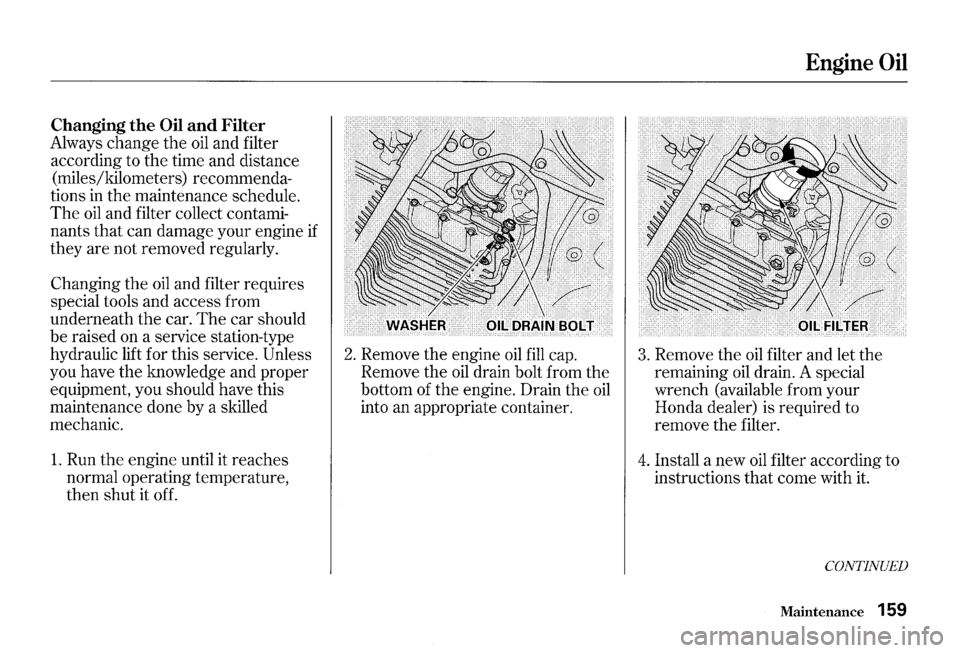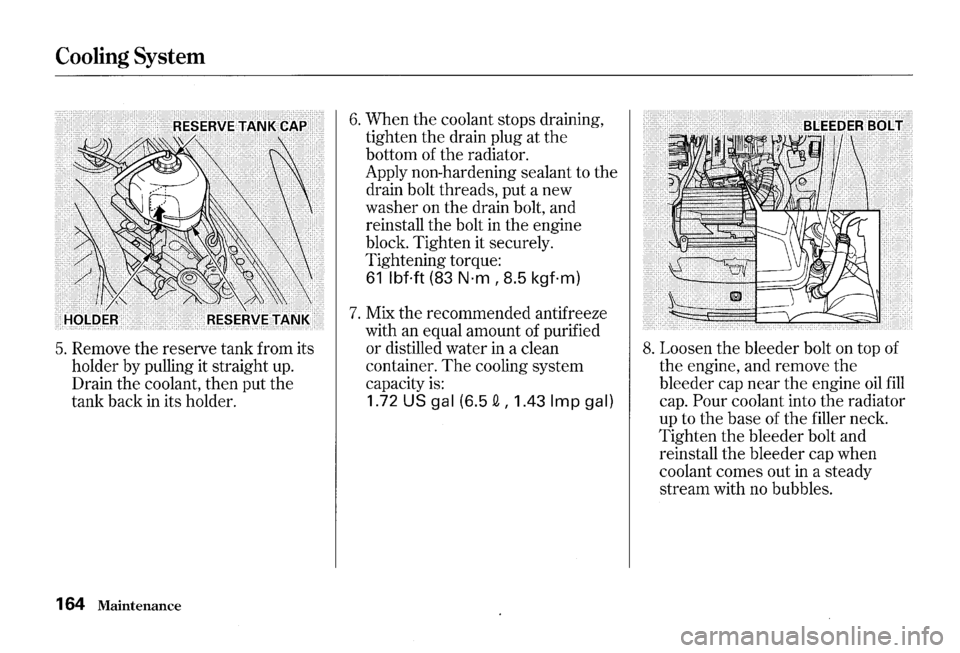2000 HONDA S2000 Recommend oil
[x] Cancel search: Recommend oilPage 146 of 273

This section explains why it is
important to keep your car well
maintained and to follow basic
maintenance safety precautions.
This section also includes
Maintenance Schedules for normal
driving and severe driving conditions,
a Maintenance Record, and instruc
tions for simple maintenance tasks
you may want to take care of
yourself.
If you have the skills and tools to per
form more complex maintenance
tasks on your Honda, you may want
to purchase
the Service Manual. See
page 259 for information on how to
obtain a copy,
or see your Honda
dealer. Maintenance
Safety .......................
144
Important
Safety Precautions .. 145
Maintenance Schedule .................. 146
Required Maintenance Record
.... 153
Owner Maintenance Checks ........ 155
Fluid Locations ............................... 156
Engine Oil ....................................... 157
Adding Oil... ................................ 157
Recommended Oil ..................... 157
Synthetic
Oil ............................... 158
Additives ..................................... 158
Changing the Oil and Filter.. .... 159
Cooling System .............................. 161
Adding Engine Coolant ............. 161
Replacing Engine Coolant ........ 163
Windshield Washers ..................... 167
6-speed Manual Transmission
Fluid ............................................
168
Differential Fluid ........................... 169
Brake and Clutch Fluid ................. 170
Brake Fluid ................................. 170
Brake System ............................. 170
Clutch System ............................ 171
Air Cleaner Element.. .................... 172
Hood Latch ..................................... 174
Maintenance
Spark Plugs ..................................... 174
Replacement ............................... 17 4
Specifications ............................. 176
Battery ............................................
177
Wiper Blades .................................. 180
Air Conditioning System ............... 182
Air Conditioning Filter, ................. 183
Drive Belt ........................................ 184
Tires ................................................ 185
Inflation ....................................... 185
Inspection ................................... 187
Maintenance ............................... 188
Tire Rotation .............................. 188
Tire Wear .................................... 188
Replacing Tires and Wheels .... 189
Wheels and Tires ....................... 190
Winter Driving ........................... 190
Snow
Tires .............................. 191
Tire Chains ............................. 191
Lights .............................................. 192
Replacing Bulbs ......................... 194
Storing Your Car ............................ 202
Maintenance 143
Page 147 of 273

Maintenance Safety
Regularly maintaining your car is the
best way to protect your investment.
Proper maintenance is essential to
your safety and the safety of your
passengers.
It will also reward you
with more economical, trouble-free
driving and help reduce air pollution.
Improperly maintaining this car
or
failing to correct a problem
before driving can cause a
crash
in which you can be
seriously hurt or killed.
Always follow
the inspection
and maintenance
recommendations and
schedules in this owner's
manual.
144 Maintenance
This section includes instructions for
simple maintenance tasks, such as
checking and adding
oil. Any service
items not detailed in this section
should be performed by a Honda
technician or other qualified
mechanic. Some
of
the most important safety
precautions are given here. However,
we cannot warn you of every
conceivable hazard
that can arise in
performing maintenance.
Only you
can decide whether or not you
should perform a given task.
Failure to properly follow
maintenance instructions and
precautions can cause you to
be seriously hurt or killed.
Always follow
the procedures
and precautions
in this owner's
manual.
Page 160 of 273

Adding Oil
To add oil, unscrew and remove the
engine oil fill cap on top of the left
valve cover.
Pour in the oil, and
replace
the engine oil fill cap.
Tighten it securely. Wait a few
minutes and
recheck the oil level. Do
not
fill above the upper mark; you
could damage the engine.
Recommended Oil
Oil is a major contributor to your
engine's performance and longevity.
Always use a premium-grade deter
gent
oil. It is highly recommended
that you use Genuine Honda Motor
oil in your vehicle for as long as you
own it.
You can determine an oil's
SAE
viscosity and Service Classification
from
the API Service label on the oil
container.
A fuel-efficient oil is recommended
for your Honda.
This is shown on the
API Service label by the words
"Energy Conserving." This oil is
formulated to help your engine use
less fuel.
Engine Oil
The API Service label also tells you
the service classification of the oil.
Always use an oil that is labeled "API
Service SJ." This service rating may
include other classifications, such as
CD. These additional classifications
are not a problem, as long as the
label also carries
the SJ classification.
CONTINUED
Maintenance 15 7
Page 162 of 273

Changing the Oil and Filter
Always change the oil and filter
according to the time and distance
(miles/kilometers) recommenda
tions
in the maintenance schedule.
The oil and filter collect contami
nants that can damage your engine
if
they are not removed regularly.
Changing the
oil and filter requires
special tools and access from
underneath
the car. The car should
be raised on a service station-type
hydraulic lift for this service.
Unless
you have the knowledge and proper
equipment, you should have this
maintenance done by a skilled
mechanic.
1. Run the engine until it reaches
normal operating temperature,
then shut it off.
2. Remove the engine oil fill cap.
Remove the
oil drain bolt from the
bottom of
the engine. Drain the oil
into an appropriate container.
Engine Oil
3. Remove the oil filter and let the
remaining
oil drain. A special
wrench (available from your
Honda dealer) is required to
remove the filter.
4. Install a new oil filter according to
instructions that come with it.
CONTINUED
Maintenance 159
Page 167 of 273

Cooling System
5. Remove the reserve tank from its
holder by pulling it straight
up.
Drain the coolant, then put the
tank back
in its holder.
164
Maintenance
6. When the coolant stops draining,
tighten the drain plug at
the
bottom of the radiator.
Apply non-hardening sealant to the
drain bolt threads, put a new
washer on the drain bolt, and
reinstall
the bolt in the engine
block. Tighten it securely.
Tightening torque:
61 lbf.ft (83 N·m I 8.5 kgf·m)
7. Mix the recommended antifreeze
with an equal amount of purified
or distilled water
in a clean
container.
The cooling system
capacity
is:
1.72 US gal (6.5 Q I 1.43 Imp gal)
8. Loosen the bleeder bolt on top of
the engine, and remove
the
bleeder cap near the engine oil fill
cap. Pour coolant into the radiator
up to the base of
the filler neck.
Tighten the bleeder bolt and
reinstall the bleeder cap when
coolant comes out in a steady
stream with no bubbles.
Page 172 of 273

Check the fluid level with the
differential at normal operating
temperature and the vehicle sitting
onlevelground.Removethe
differential fluid filler bolt and
washer and carefully feel inside the
bolt hole with your finger.
The fluid
level should
be up to the edge of the
bolt hole.
If it is not, slowly add fluid
until it starts to run out of
the hole.
Use a SAE 90 viscosity hypoid gear
oil, API service classified GL5 or
GL6 only, in the differential.
Put a new washer on the filler bolt,
then reinstall the filler bolt. Tighten
it securely. Tightening torque:
33 lbf·ft (45 N·m, 4.6 kgf·m)
The differential should be drained
and refilled with new fluid according
to the time and distance
recommendations in the
maintenance schedule.
Differential Fluid
Maintenance 169
Page 177 of 273

Hood Latch, Spark Plugs
Hood Latch
Clean the hood latch assembly with a
mild cleaner, then lubricate it with a
multipurpose grease. Lubricate
all
the moving parts, including the pivot.
Follow the time and distance
recommendations
in the
Maintenance Schedule.
If you are
not sure how to clean and grease the
latch, contact your Honda dealer.
17 4 Maintenance
Spark Plugs
The spark plugs in your car are a
special platinum-tipped design for
longer life.
They only need to be
replaced every 7 years or
105,000
miles (168,000 km), whichever
comes first.
Replacement
1. Remove the four hexagon socket
head cap bolts holding the ignition
coil cover.
2. Clean up any dirt and oil that have
collected around the ignition coils.
Page 269 of 273

Index
Opening the Hood ......................... 118 Protecting Small Children .......... 26 Replacing Seat Belts After a
Opening the Trunk .......................... 66 Crash ............................................. 34
Operation in Foreign Countries
... 249 R Restraint, Child ................................ 19
Outside Mirrors ............................... 79 Rotation, Tire ................................. 188
Overheating, Engine ..................... 223 Radiator Overheating .................... 223
Oxygenated Fuels .......................... 248 Radio Sound System ........................ 94 s
Rear End Towing ........................... 238 p Rear Lights, Bulb Replacement ... 198 Safety Belts ......................................... 8
Rear
View Mirror ............................. 79 Safety Defects, Reporting ............. 258
Paint Touch-up ............................... 206 Reclining the Seat-backs ................. 68 Safety Labels, Location of .............. 40
Panel Brightness Control ............... 52 Recommended Shift Speeds ........ 134 Safety Messages ................................ ii
Parking Brake .................................. 80 Recovery Vehicle, Emergency Seat Belt, Additional Information .. 33
Parking Lights .................................. 51 Towing ........................................ 238 Lap/Shoulder Belt ....................... 33
PGM-FI System .............................. 251 Reminder Lights .............................. 43 Seat Belt Maintenance ................ 34
Polishing and Waxing ...................
205 Remote Transmitter ........................ 63 Seat Belt System Components ... 33
Power Replacement Information Seat Belts ............................................ 8
Door Locks ...................................
62 Air Cleaner ................................. 172 Cleaning ...................................... 207
Engine, Specifications ............... 244 Engine
Coolant.. ......................... 163 Maintenance ................................. 34
Mirrors .......................................... 79 Engine Oil and Filter ................. 159 Reminder Light and Beeper ....... 44
Windows ....................................... 69 Fuses ........................................... 232 System Components .................... 33
Pregnancy, Using Seat Belts .......... 17 Light Bulbs ................................. 194 Use During Pregnancy ................ 17
Protecting Adults ............................. 12 Schedule ..................................... 146 Seats, Adjusting the ......................... 68
Additional Safety Precautions .... 18 Spark Plugs ................................. 17 4
Serial Number ................................ 242
Advice for Pregnant Women ...... 17 Tires ............................................ 189 Service Intervals ............................ 146
Protecting Children .........................
19 Wiper Blades .............................. 180 Service Manual .............................. 259
Protecting Larger Children ........
29 Service Station Procedures .......... 117
VI